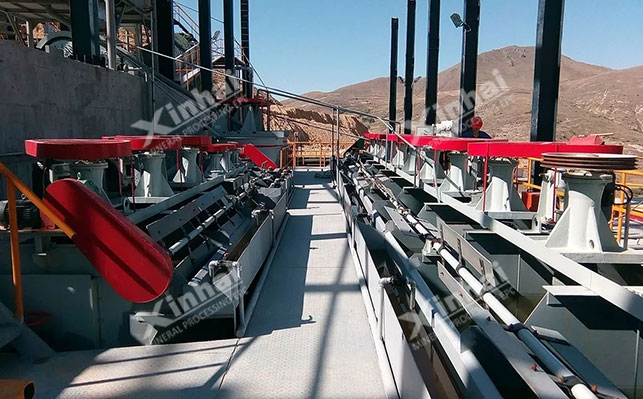Copper, lead and zinc are widely used in military, chemical, and applied materials industries. They often coexist and exist in the form of sulfides in the earth's crust. The surface properties of the three sulfides are very different, which makes it very difficult to separate them. Although copper, lead and zinc mineral resources are abundant, they are of low grade and have fine particle size. This article takes a low-grade copper, lead and zinc sulfide ore as an example to explain the flotation process.
The contents of copper, lead and zinc in the original ore are 0.43%, 1.22% and 0.42% respectively. The main mineral of copper is chalcopyrite, the main mineral of lead is galena, the main mineral of zinc is sphalerite, and other metal minerals mainly include pyrite.

The raw ore adopts the process of copper-lead sequential priority flotation-zinc-sulfur mixed flotation and re-separation. The main processes are as follows:
(1) Crushing and screening stage
The raw ore is coarsely crushed by a jaw crusher, finely crushed by a cone crusher, and crushed with a linear vibrating screen before entering the grinding stage.
(2) Grinding and classification stage
The grinding stage adopts two-stage grinding. The first stage uses a grate ball mill and a spiral classifier; the second stage uses an overflow ball mill and a hydrocyclone. Finally, the mineral is ground to a content of -0.074mm, accounting for 85%.
(3) Flotation stage
a. Copper mineral flotation
After grinding, the materials are added with lime as an adjusting agent, combined inhibitors of zinc sulfate, sodium sulfite and sodium sulfide, highly selective copper collector BK916 and frother BK204 to carry out copper mineral flotation;
b. Lead mineral flotation
Combined inhibitors of zinc sulfate, sodium sulfite and sodium sulfide, highly selective lead collector BK906 are added to the copper flotation tailings to carry out lead mineral flotation;
c. Zinc-sulfur mixed flotation
Sodium carbonate as an adjusting agent, copper sulfate as an activator, butyl xanthate as a collector and frother BK204 are added to the lead flotation tailings to carry out zinc-sulfur mixed flotation. The zinc-sulfur mixed flotation rough concentrate is selected to obtain zinc-sulfur mixed concentrate.
d. Zinc-sulfur separation
Before zinc-sulfur separation, the mineral is re-grinded to -0.038mm, accounting for 80%, and then enters the flotation process of one roughing, two sweeping and two fines. Lime and 150g/tBD inhibitor are added during the roughing of zinc-sulfur separation. Zinc concentrate is obtained after two rounds of concentration, and sulfur concentrate is obtained after two rounds of scavenging.
(4) Concentration and dehydration stage
The selected concentrate is sent to the thickener for concentration and dehydration to obtain the concentrate. The tailings can be piled up after dry discharge, or used for road paving, building material addition, etc.
After the above beneficiation process, the low-grade sulfide lead-zinc ore was properly processed, and the final beneficiation results were also quite gratifying. Copper concentrate with a copper grade of 20.68% and a copper recovery rate of 72.98%, lead concentrate with a lead grade of 61.38% and a lead recovery rate of 73.57%, zinc concentrate with a zinc grade of 46.31% and a zinc recovery rate of 73.17%, and sulfur concentrate with a sulfur grade of 48.54% were obtained.